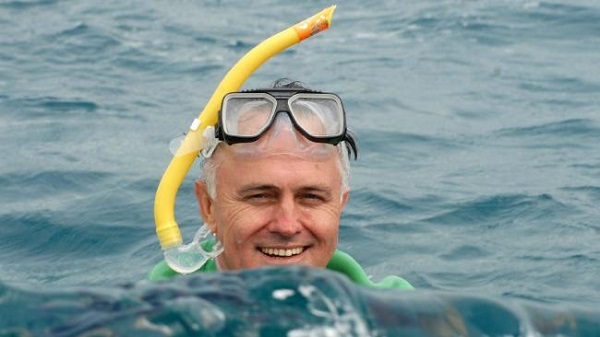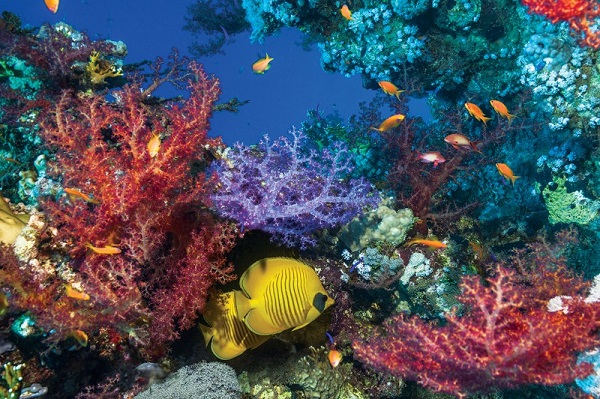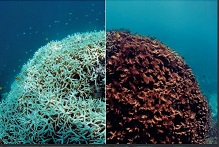Malcolm Turnbull has announced a $60 million package to rescue the Great Barrier Reef. If you believe him!
Here are two headlines, the first from an article from last year by scientists from the Australian Institute of Marine Science:
The second is from the New Scientist (probably pay-walled):
On closer inspection the New Scientist seems to be relying on the Australian Marine Conservation Society, which really means Imogen Zethoven, whose Linked in profile shows that her basic qualification was a BA (Hons) in English in the University of Wellington, followed by a Masters Env Studies, Environmental economics, environmental law, ecosystem processes at the University of Adelaide. She says she enjoys “developing and running big impact environment campaigns for non-governmental organizations around the world”, which she’s been doing for 25 years, and what she is good at is “strategic planning, political advocacy, campaign communications, outreach, networking, meeting facilitation and team management.”
A more balanced and informed view comes from David Suggett, Associate Professor in Marine Biology, University of Technology Sydney in his article $60 million to save the Great Barrier Reef is a drop in the ocean, but we have to try.
He has two main cautions. One is that all four elements of the funded program are interdependent, so for any one to work they all have to work.
The other is this:
- And of course, all of this will count for nothing unless we also take parallel action to tackle the underlying problem: climate change. (Emphasis added)
Which confirms the concerns of Zethoven and other environmental groups who have said similar things about the initiative.
Suggett has a neat summary of what is included:
- A$36.6 million will be spent on reducing the runoff of land-based agricultural fertilisers and pesticides onto the reef
- A$10.4 million will go towards an “all-out assault” on the coral-eating crown-of-thorns starfish
- A$4.9 million will fund improved monitoring and early warning of issues such as mass bleaching
- A$6 million will be spent on a new national Reef Restoration and Adaptation program.
The lead institution in the Reef Restoration and Adaptation program is the Australian Institute of Marine Science with an impressive liost of partners:

If you look at Josh Frydenberg’s media release, he does not promise to save the Reef. In fact what really excites him is the science and innovation we will be embarking on and what that will do to our international reputation. So much so that the carriage of the initiative is with Minister for Jobs and Innovation Michaelia Cash, who doubles as science minister.
However, nothing is going to be actually done in the first instance, because the $6 million:
- will go to the Australian Institute of Marine Science and the CSIRO to scope and design this program over the next 18 months, including looking at how best to leverage private investment.
For what it is all about, best go back to the first link in the post above. Seems there are two main elements.
Firstly, they plan to take corals surviving in the warmer northern waters and seed the southern reefs. The South Equatorial Current that flows west across the Pacific splits into the north-flowing Gulf of Papua Current and south-flowing East Australian Current off the coast of north Queensland, which means coral larvae spawned in the warm north are likely to stay in the north.
So it’s manual pick and carry job.
The second part is ‘assisted evolution’ which they say is “artificial selection on steroids”. It involves hybridisation and fast-tracking the evolution of algal symbionts in isolation from the coral host.
The $60 million splash was given very positive treatment in the Courier Mail in Malcolm Turnbull pledges $60m to protect Great Barrier Reef (pay-walled).
The dead tree version had a banner headline that took up most of the front page:
-
FUTURE PROOF SUPER CORAL
under a red headline – TURNBULL’s REEF-OLLUTION
In the article Dr Line Bay, senior research scientist at The Australian Institute of Marine Science, said:
- scientists were trying to develop a backup plan for the Reef that included “accelerating naturally occurring evolutionary processes to enhance certain traits that are important for the health and survival (of coral)”.
“These approaches range from assisted gene flow and the selective breeding of stress-tolerant coral stock, to active selection and manipulation of microbial symbionts with the aim of enhancing the stress tolerance of the coral animal,” Dr Bay said.
Assisted gene flow includes moving heat-tolerant corals to cooler reefs that are warming, to help buffer the Reef from future bleaching caused by warmer-than-normal water temperatures.
The notion of a “backup plan” is probably over-reach. Remember the GBR consists of some 2900 individual reefs covering 344,000 square kilometres, stretching 2300 km along the coast. It plays host to:
-
600 types of soft and hard corals, more than 100 species of jellyfish, 3000 varieties of molluscs, 500 species of worms, 1625 types of fish, 133 varieties of sharks and rays, and more than 30 species of whales and dolphins.
Malcolm Turnbull said:
-
“This four-pronged approach will help secure the Reef’s future and the thousands of jobs that rely on it,’’ he said.
“The Reef is a national treasure. The groundbreaking research that can now be undertaken will help secure the Reef’s future for decades to come.”
Good as done. Here is the PM happy in his work, with the caption “Prime Minister Malcolm Turnbull hopes his plan for the Reef will protect it from bleaching.”

An outfit called Eco-Business has an article Australia’s $60 million plan to save the Great Barrier Reef dismissed as ‘meaningless’ which quotes Zethoven again, plus Greenpeace and this:
Scientists also criticised the plan as one that would be ultimately ineffective in protecting the reef.
-
Jon Brodie, professorial fellow, ARC Centre of Excellence for Coral Reef Studies at James Cook University, told local media that programmes to remove the Crown of Thorns starfish had “minimal impact” on population numbers. He also pointed out that the government was not spending nearly as much as it should on this endangered ecosystem.
As AMCS’s Zethoven pointed out, the Queensland government has found that A$800 million a year is required over the next decade to improve the health of the reef.
“The government must get serious and make investment in this order of magnitude,” Zethoven said.
She added: “The Prime Minister needs to exert leadership on climate change and the Reef. He is well aware of the problem but his solutions are so far woefully disproportionate to the problem.”
That’s about right, I think.
Meanwhile the Queensland State government welcomed the $60 million program as a start to what is needed, while outlining the $256 million they are spending over the next five years, plus calling for a “robust national policy to address the challenges of climate change.”
Since then the Queensland government has also announced a $450,000 trial to use bioreactors to reduce agricultural run-off from entering the Great Barrier Reef from cane and banana farms.
Here’s a photo of the reef. In 50 years time photos and videos may be the main way people experience pristine reefs:



Way, way back in ancient history – around 1978 to 1984 – there was concern about agricultural fertilizers, agricultural fertilizer metabolites, pesticides and herbicides washing down into the Great Barrier Reef. “Hey, that’s the farmers’ money going down the gurgler! Do something about it!”
However, because those who raised alarm about this waste of money were not members of the boards of multinational conglomerates, nor members of the Land Rights For Gay Whales Action Alliance (inc.) nor did they have a string of alphabet soup after their names, they were safely ignored. Many of the concerned citizens who raised that alarm have long since gone to Heaven – but their simple yet very awkward question still remains here on Earth.
So, why, 40 odd tears later, is farmers’ hard-earned money still going down the gurgler to end up on the Great Barrier Reef. Yes, yes, the litany of “Mitigation Achieved” really does belong on the Eurovision Song Contest and not on a serious discussion of the future of the Great Barrier Reef
Good approach Graham.
If a few dills couldn’t care less about reef life, or think that the Seas dilute and wash away all our sins, simply point out the
sheer waste of farmers’ money
involved, as agricultural chemicals and fertilisers miss the intended targets and leave the farm properties, entering that other, wider realm where the non-farmers, fish and corals live.
Graham Bell (Re: FEBRUARY 5, 2018 AT 8:44 PM):
Here’s 7 reasons why humanity needs to transform the use of phosphorus.
You beauty, Geoff M.!
Excellent summary of what’s wrong with our misuse of phosphorus. It did mention troublesome stuff like entrained cadmium in the phosphorus rock too.
And don’t forget that other competitor for phosphorus: metallurgical industry.
Thanks, Geoff M. I always like to see the date on information. That one seems to be based on a 2014 article, so probably up to date enough to be relevant.